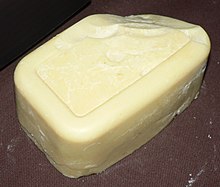Cocoa butter
This article needs additional citations for verification. (May 2008) |

Cocoa butter, also called theobroma oil or theobroma cacao, is a pale-yellow, pure edible vegetable fat extracted from the cacao bean. It is used to make chocolate, pharmaceuticals, ointments, and toiletries.[1] Cocoa butter has a mild chocolate flavor and aroma.
Creation
Cocoa beans are ground into chocolate liquor and pressed to separate the cocoa butter from the cocoa solids [2]. Cocoa butter can alternately be extracted from whole beans by the broma process. It is most often deodorized to remove its strong and undesirable taste[3].
Uses
Milk and sugar are added to make white chocolate, but most of it is used to produce milk chocolate, some of which contains more cocoa butter than cocoa liquor.
Because of the low melting point of cocoa butter, it is often used in pharmaceuticals as a base for suppositories. It is typically solid at room temperature, but readily melts at body temperature, releasing the medication. Cocoa Butter rubbed on nipples can impede lactation.
Cocoa butter is one of the most stable fats known, containing natural antioxidants that prevent rancidity and give it a storage life of two to five years, making it a good choice for non-food products. The smooth texture, sweet fragrance and emollient property of cocoa butter make it a popular ingredient in cosmetics and skin care products, such as soaps and lotions.
Chemical properties
The most common form of Cocoa butter has a melting point of around 34 to 38 degrees Celsius (93 to 100 degrees Fahrenheit), rendering chocolate a solid at room temperature that readily melts once inside the mouth. Cocoa butter displays polymorphism, having α, γ, β', and β crystals, with melting points of 17, 23, 26, and 35–37 °C respectively. The production of chocolate typically uses only the β crystal for its high melting point. A uniform crystal structure will result in smooth texture, sheen, and snap. Overheating cocoa butter converts the structure to a less stable form that melts below room temperature. Given time, it will naturally return to the most stable β crystal form.
References
- ^ "Cocoa butter -- Britannica Online Encyclopedia". Britannica Encyclopedia article. July 1998. Retrieved 2007-09-10.
- ^ Cocoa butter pressing
- ^ Template:Web
